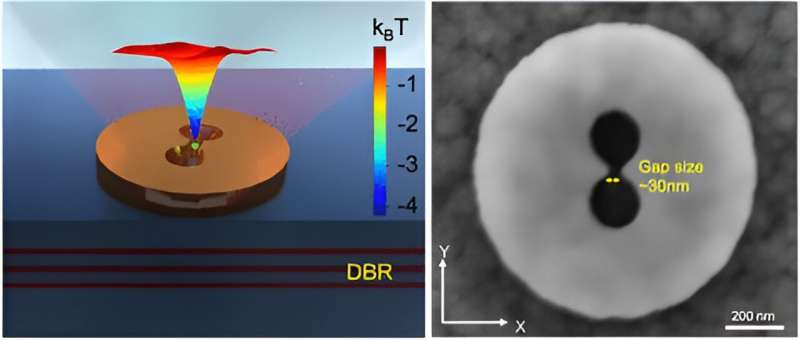
Justus Ndukaife, assistant professor of electrical and computer engineering at Vanderbilt University, is leading innovative research that more effectively traps nanosized extracellular vesicles and particles (EVPs) to analyze their roles in cancer, and neurodegenerative diseases.
The research, done in collaboration with the lab of Vanderbilt Professors Robert Coffey and Kasey Vickers, was recently published in Nano Letters.
EVPs—including recently discovered exomeres and supermeres—are thousands of times smaller than the thickness of a human hair. By trapping and manipulating them, researchers aim to better understand how cells package molecules and interact with one another, which may also shed light on the formation of diverse diseases, like cancer and Alzheimer’s.
However, when using optical tweezers, there’s a risk of photothermal heating that could adversely affect the EVPs. In their paper, Ndukaife and his team discuss using an anapole antenna to condense the electromagnetic energy to the nanoscale and successfully trap EVPs using a lower laser power.
“Since the proposed trapping system is low-loss, it precludes local temperature rises and thus ensures that important biological particles and molecules remain intact,” according to the paper.
The development of optical tweezers was recognized with the 2018 Nobel Prize in Physics for their efficacy in trapping single cells and larger EVs. Ndukaife developed the first-ever opto-thermo-electrohydrodynamic tweezer (OTET) that can trap and manipulate objects on the sub-10 nanometer scale at Vanderbilt in 2020.
More information:
Ikjun Hong et al, Anapole-Assisted Low-Power Optical Trapping of Nanoscale Extracellular Vesicles and Particles, Nano Letters (2023). DOI: 10.1021/acs.nanolett.3c02014
Journal information:Nano Letters
Provided by
Vanderbilt University

READ MORE
Pluto Probe Finds Surprises Ahead of Its Close Encounter
Hello, Pluto! We <3 you, too. NASA/Johns Hopkins University APL/SwRI Pluto has long been a [...]
A targeted polymer to treat colorectal cancer liver metastases
The polymer in the bloodstream and its binding to E-selectin, which is expressed exclusively on [...]
CERN Wants to Build a Bigger, Badder Particle Collider
This aerial view shows the difference in size between the current Large Hadron Collider and [...]
How the Turtle Got Its Shell, With Apologies to Aesop
/ In a fit of pique, according to one of Aesop’s fables, the god Hermes [...]
Scientists design novel nonlinear circuit to harvest clean power using graphene
Credit: AlexanderAlUS/Wikipedia/CC BY-SA 3.0 Obtaining useful work from random fluctuations in a system at thermal [...]
Why Do the Planets All Orbit the Sun in the Same Plane?
The planets in our solar system all orbit the Sun in one shared plane. Illustration [...]
How Light Pollution Works
The Chicago River is hard to miss, even at dusk. Chris Pritchard/Photodisc/Getty Images Humans have [...]
Flexible strain sensor enabled by carbon nanofibers can ‘read lips’
Scientists from Tsinghua University debuted a flexible strain sensor design that achieves high sensitivity and [...]